- Home
- Sue Grafton
I Is for Innocent Page 2
I Is for Innocent Read online
Page 2
Morley Shine had been around ever since I could remember, not a close friend, but certainly a man I could count on if I found myself in a pinch. He and the fellow who’d trained me as a P.I. had been partners for years. At some point, they’d had a falling-out and each had gone into business for himself. Morley was in his late sixties, tall and slump-shouldered, probably eighty pounds overweight, with a round, dimpled face, wheezing laugh, and fingers yellowed from all the cigarettes he smoked. He had access to snitches and informants in every correctional facility in the state, plus contacts in all the relevant local information pools. I’d have to quiz Lonnie later about the circumstances of Morley’s death. For the time being, I concentrated on Kenneth Voigt, who had backed up his narrative so he could get a running start.
He stared down at the floor, hands clasped loosely in his lap. “My ex-wife was murdered six years ago. Isabelle Barney. You remember the case?”
The name meant nothing. “I don’t think so,” I said.
“Someone unscrewed the fisheye in the middle of the front door. He knocked, and when she flipped on the porch light and peered out, he fired a thirty-eight through the spyhole. She died instantly.”
My memory kicked in with a jolt. “That was her? I do remember that much. I can’t believe it’s been six years.” I nearly added my only other recollection, that the guy alleged to have killed her was her estranged husband. Apparently not Kenneth Voigt, but who?
I made eye contact with Lonnie, who interjected a comment, picking up on my question as if with ESP. “The guy’s name is David Barney. He was acquitted, in case you’re curious.”
Voigt changed positions in his chair as if the very name made him itch. “The bastard.”
Lonnie said, “Go on with your story, Ken. I didn’t mean to interrupt. You might as well give her the background as long as she’s here.”
It seemed to take a few seconds for him to remember what he’d been saying. “We were married for four years . . . a second marriage for both. We have a ten-year-old daughter named Shelby who’s off at boarding school. She was four when Iz was killed. Anyway, Isabelle and I had been having problems . . . nothing unusual as far as I knew. She got involved with Barney. She married him a month after our divorce became final. All he wanted was her money. Everybody knew that except poor, dumb Iz. And I don’t mean any insult to her when I say that. I loved the woman, truly, but she was gullible as they come. She was bright, and she was talented, but she had no sense of self-worth, which made her a sitting duck for anybody with a kind word. You probably know women like that. Emotionally dependent, no self-esteem to speak of. She was an artist, and while I had tremendous admiration for her ability, it was hard to watch her throw her life away. . . .”
I found myself tuning out his analysis of her character. His generalizations about women were obnoxious and he’d evidently told the same story so often his rendering of events was flat and passionless. The drama was not about her anymore, it was the tale of his reaction. My eye wandered over to the pile of fat manila folders on Lonnie’s desk. I could see VOIGT/BARNEY written across the spine. Two cardboard boxes stacked against the wall contained additional files, judging by the labels affixed to one side. Everything Voigt was saying was going to be right there, a compilation of facts without all the editorials attached. It seemed weird to me—what he said might be true, but it wasn’t necessarily believable. Some folks are like that. The simplest recollection just sounds false in the rendering. He went on for a bit, speaking in closely knit paragraphs that didn’t yield the opportunity for interruption. I wondered how often Lonnie had served as his audience. I noticed he’d disconnected, too. While Kenneth Voigt’s mouth was moving, Lonnie picked up a pencil and began to turn it end over end, tapping on his legal pad first with the point and then with the eraser. I returned my attention to Ken Voigt.
“How’d the guy get off?” I asked as soon as he paused for breath.
Lonnie jumped in, apparently impatient to get down to the meat of the matter. “Dink Jordan prosecuted. What a yawn that was. Jesus. I mean, the man is competent but he’s got no style. He thought he could win on the merits of the case.” Lonnie snorted at the absurdity of the assumption. “So now we’re suing the shit out of David Barney for wrongful death. I hate the guy. Just hate him. The minute he pled not guilty, I told Ken we should jump on the son of a bitch with hobnail boots. I couldn’t talk him into it. We filed and got him served, but then Ken insisted we sit on it.”
Voigt frowned uncomfortably. “You were right, Lon. I see it now, but you know how it is. My wife, Francesca, was opposed to our reopening the investigation. It’s painful for everyone . . . me more than most. I simply couldn’t handle it.”
Lonnie crossed his eyes. He didn’t have a lot of sympathy for what people could or couldn’t handle. His job was to handle it. Voigt’s job was to turn him loose. “Hey, okay. Skip that. It’s water under the bridge. It took a year to get him tried and acquitted on the criminal charges. In the meantime, Ken here watches David Barney work his way through Isabelle’s money. And believe me, there’s plenty of it, most of which would have gone to his daughter, Shelby, if Barney’d been convicted. Finally, the family reaches a point where they can’t stand it anymore, so Ken comes back to me and we get into gear. Meanwhile, Barney’s attorney, guy named Foss, files a discretionary motion to dismiss for lack of prosecution. I whip into court and tap-dance my tiny heart out. The motion was denied, but the judge made it clear he wasn’t happy with me.
“Now, of course, David Barney and this jerk who represents him are using every delay they can think of, and then some. They dicker around and dicker around. We’re going through all the discovery, right? The guy’s been acquitted in criminal court so what difference does it make what he says at this point? But he’s tight-lipped. He’s tense. That’s because he’s guilty as hell. Oh, and here. Check this. Ken here has a guy show up . . . turns out he shared a cell with David Barney. This guy’s been following the case. He sits in on the trial, just to see what’s going on, and he’s telling us Barney as good as admitted he killed her as he’s walkin’ out the courtroom door. The informant’s been hard to nail down, which is why I want to get the sucker served first thing.”
“What good’s it going to do?” I asked. “David Barney can’t be tried again on the murder one.”
“Exactly. Which is why we kicked it over to the civil side. We’ve got a much better shot at him there, which he damn well knows. The guy’s really dragging his feet, doing everything he can to hinder and obstruct. We file a motion. He’s got thirty days to answer so his attorney—what a geek—waits until day twenty-nine and then files a demurrer. Anything to string it out. He’s throwing up roadblocks left and right.
“We bring Barney in for a deposition and he pleads the Fifth. So we take him into court and force him to testify. The judge orders the guy to answer because he has no Fifth Amendment rights. There’s no danger of prosecution because jeopardy has attached. Back we go on the depo. So now he takes the Fifth again. We take him in on the contempt, but in the meantime we’re running up against the court statute—”
“Lonnie?” I said.
“We’re humming and humming and it’s not working for us. We’re coming up to the five-year statute and we really need to make the case happen. We’re on the master calendar and we’ve been given priority, and now Morley drops dead—”
“Looonnnnie,” I sang. I raised my hand to get his attention.
He stopped.
“Just tell me what you need and I’ll go out and get it for you.”
Lonnie laughed and tossed his pencil at me. “This is why I like her. No bullshit,” he said to Voigt. He reached over and pushed the stack of files in my direction. “This is everything we got, though it’s a bit disorganized. There’s an inventory on top—just make sure it’s all in there somewhere before you start work. Once you’re familiar with the basics, we can figure out where the gaps are. In the meantime, I want you two to get acquainted.
You’re going to be seeing a lot of each other in the next month.”
Voigt and I smiled politely at Lonnie without looking at one another. He didn’t seem to feel any more excited about the prospect than I did.
2
I ended up staying at the office until midnight. The accumulated files on Isabelle Barney spilled over the tops of the two cardboard cartons, each of which weighed over forty pounds. I nearly developed a hernia hauling the boxes from Lonnie’s office to mine. There was no way I could get through all the data at one sitting so I figured I might as well take my time. Lonnie wasn’t kidding when he said the files were disorganized. According to the inventory, the first box should have contained copies of police reports, transcripts from the murder trial, the complaint Lonnie’d filed in the civil action in the Santa Teresa County Superior Court, all the demurrers, answers, and cross-complaints. I couldn’t even be sure that the trial transcripts were complete. What files I could spot were lumped together in one of those annoying hodgepodges that make finding anything a chore.
The second box supposedly contained copies of all of Morley Shine’s reports, affidavits, transcripts from the numerous depositions taken, and pages of supporting documentation. Fat chance. I could see the list of witnesses that Morley had talked to—he’d been billing Lonnie on a regular monthly basis since June 1—but not all of the corresponding written reports were in evidence. It looked like he’d served about half the subpoenas for the upcoming trial, but most of those seemed to be repeat witnesses from the criminal proceedings. Eight signed civil subpoenas, with instructions for service attached, were clipped together in a folder. I didn’t see that he’d served any new witnesses . . . unless the yellow server’s copies were filed somewhere else. From a scribbled note, I gathered that the informant’s name was Curtis McIntyre, whose telephone number was a disconnect and whose last known address was no good. I made a note to myself to track him down first as per Lonnie’s request.
I leafed through page after page of interrogatories and responses, making an occasional note to myself. As with a jigsaw puzzle, what I hoped to do was to familiarize myself with the picture on the box lid and then proceed to put the pieces together one section at a time. I knew I’d be repeating some of Morley Shine’s investigation, but his approach tended to be a bit ham-fisted and I thought I’d do better if I started from scratch, at least in the sensitive areas. I wasn’t sure what to do about the gaps in the files. I hadn’t finished going through the boxes yet and I could tell I was going to have to empty everything out and repack the data so they would match the index. Certain avenues Morley’d pursued appeared to be dead ends and could probably be eliminated unless something new cropped up. He’d probably been keeping all the current files in his office or at home, which I did myself if I was still in the process of transcribing notes.
The bare bones of the story were much as Kenneth Voigt had indicated. Isabelle Barney died sometime between 1:00 and 2:00 A.M. on December 26 when a .38-caliber weapon was fired at point-blank range through the peephole in her front door. The ballistics expert called it “a near-contact shooting,” with the hole in the door acting almost like an extension of the barrel and Isabelle’s eye almost touching the door. The wood around the hole was blown out at right angles to the hole and toward Isabelle, with some fragments probably blown back toward the killer as well. In a dry parenthetical note, the ballistics expert suggested that the blast might well have forced “material” back into the barrel itself, perhaps jamming the gun, and thus making a second shot problematic, if not impossible. I skipped the rest of that paragraph.
The muzzle flash had singed the wood inside the hole, charring it slightly. The report noted powder residue on the outside of the door around the hole, inside the hole, and also around the hole on the inside of the door. Much of the area was splintered by the gas pressure. The bird shot and the remnants of blue plastic cap removed from the wound indicated that the bullet was a Glaser Safety Slug, a light, high-velocity round consisting of bird shot suspended in a viscous medium encased in a copper jacket with a plastic nose cap. When the slug hits a medium like flesh with a high water content, the plastic cap separates, the copper jacket peels back, and the bird shot spreads out rapidly, transferring all of the energy in the slug to the flesh. Because each piece is small and of low mass, it dumps its energy quickly and stays in the body, hence the name Safety Slug. Bystanders are not endangered by an overpenetrating bullet, and since the Safety Slug also disintegrates against hard surfaces (such as skulls . . . ), ricochets are minimized as well. No getting around it, I thought, this killer was just too considerate.
According to the pathologist, the bullet, along with fragments of metal and wood, entered the victim’s right eye. The autopsy report spelled out in highly technical detail the destruction to soft tissue left in its wake. Even with my sketchy knowledge of anatomy, it was clear death was instantaneous and therefore painless. The machinery of life had shut down long before the nervous system had a chance to register the agony such a wound would inflict.
It’s hard to have faith in your fellow man when you’re forced to look at some of his handiwork. I disconnected my emotional machinery while I studied the autopsy x–rays and photographs. I work best when I’m armed with an unflinching view of reality, but the detachment is not without its dangers. Unplug yourself often and you risk losing touch with your feelings altogether. There were ten color photographs, each with a nightmarish quality of violated flesh. This is what death is, I reminded myself. This is what homicide really looks like in the raw. I’ve met killers—soft-spoken, pleasant, and courteous—whose psychological denial is so profound that their perpetration of a killing seems inconceivable. The dead are mute, but the living still have voice with which to protest their innocence. Often their objections are noisy and pious, impossible to refute since the one person who could condemn them has been silenced forever. The final testimony from Isabelle Barney was framed in the language of her fatal injury, a devastating portrait of waste and loss. I tucked the pictures back in the envelope and moved on to a copy of the case notes Dink Jordan had sent over to Lonnie.
Dink’s real name was Dinsmore. He referred to himself as Dennis, but nobody else did. He was in his fifties, bland and gray, a man without energy, humor, or eloquence. As a public prosecutor he was competent, but he had no sense of theater. His delivery was so slow and so methodical it was like reading the entire Bible through a microscope. I’d once watched him lay out his closing arguments in a spectacular felony murder trial with two jurors nodding off and two more so bored they were nearly comatose.
David Barney’s attorney was a man named Herb Foss, whom I didn’t know at all. Lonnie claimed he was a jerk, but you had to give him credit for getting David Barney off.
While there had been no witnesses to the shooting and the murder weapon was never found, evidence showed that Barney had purchased a .38-caliber revolver some eight months before the murder. He claimed the gun had been removed from his bed table at some point during the Labor Day weekend, when the couple had given a large dinner party in honor of some friends from Los Angeles, Don and Julie Seeger. When he was questioned about his reasons for not filing a police report, he maintained that he’d discussed it with Isabelle, who’d been reluctant to confront her guests with the alleged theft.
During the trial, Isabelle’s sister testified that the couple had been talking for months about a separation. David Barney contended that the breach between them wasn’t serious. However, the gun theft incident precipitated a quarrel, which culminated in Isabelle’s ordering him to move out. There seemed to be much disagreement about the prognosis for the marriage. David Barney claimed the relationship was stable but stormy, that he and Isabelle had been in the process of negotiating their differences. Observers seemed to feel that the marriage was dead, but that might have been wishful thinking on their part.
Whatever the truth, the situation deteriorated rapidly. David Barney moved out on September 15 and then pro
ceeded to do everything in his power to regain Isabelle’s affections. He made frequent phone calls. He sent flowers. He sent gifts. When his attentions became annoying, instead of giving her the breathing space she requested, he redoubled his efforts. He left a single red rose on the hood of her car every morning. He left jewelry on her doorstep, sent her sentimental cards in the mail. The more she rejected him, the more obsessed he became. During October and November, he called her day and night, hanging up if she answered. When she had her number changed, he managed to acquire the new unlisted number and continued phoning her at all hours. She got an answering machine. He continued to call, leaving the line open until the message tape ran out. She told friends she felt she was under siege.
In the meantime, he leased a house in the same stylish section of Horton Ravine. If she left the house, he followed her. If she stayed home, he parked across the road and watched the house through binoculars, keeping track of visitors, repairmen, and the household help. Isabelle called the police. She filed complaints. Finally, her attorney had a restraining order issued, prohibiting phone calls, written communication, and his approach anywhere within two hundred yards of her person, her property, or her automobile. His determination seemed to subside, but by then the harassment had taken its toll. Isabelle was terrified.
By the time Christmas came, she was a nervous wreck, eating little, sleeping poorly, subject to anxiety, panic, and tremors. She was pale. She was haggard. She was drinking too much. She was agitated by company and frightened to be alone. She sent the four-year-old Shelby to live with her father. Ken Voigt had remarried, though some witnesses suggested that he’d never quite recovered from his divorce from her. Isabelle took tranquilizers to get through the day. At night, she popped down sleeping pills. Finally, the Seegers prevailed on her to pack her bags and accompany them on a trip to San Francisco. They were en route to Santa Teresa to pick her up when the electronic fuel injection on the car went out. They called and left a message to let her know they’d be late.

 S Is for Silence
S Is for Silence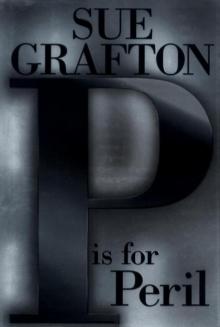 P Is for Peril
P Is for Peril R Is for Ricochet
R Is for Ricochet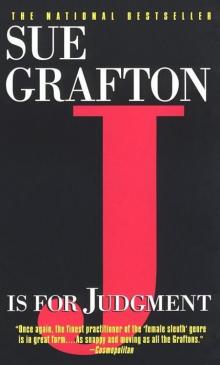 J Is for Judgment
J Is for Judgment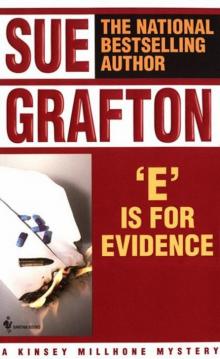 E Is for Evidence
E Is for Evidence T Is for Trespass
T Is for Trespass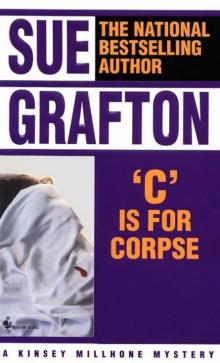 C Is for Corpse
C Is for Corpse U Is for Undertow
U Is for Undertow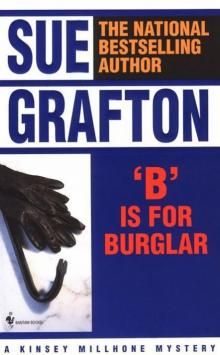 B Is for Burglar
B Is for Burglar Four Sue Grafton Novels
Four Sue Grafton Novels D Is for Deadbeat
D Is for Deadbeat K Is for Killer
K Is for Killer I Is for Innocent
I Is for Innocent A Is for Alibi
A Is for Alibi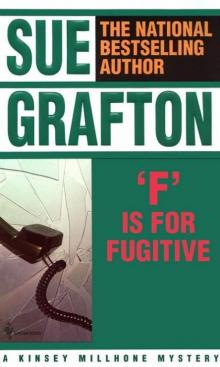 F Is for Fugitive
F Is for Fugitive Q Is for Quarry
Q Is for Quarry W Is for Wasted
W Is for Wasted Kinsey and Me: Stories
Kinsey and Me: Stories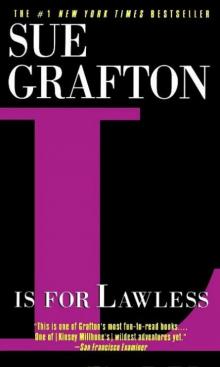 L Is for Lawless
L Is for Lawless Y Is for Yesterday
Y Is for Yesterday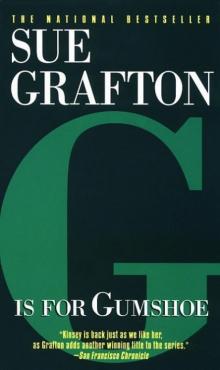 G Is for Gumshoe
G Is for Gumshoe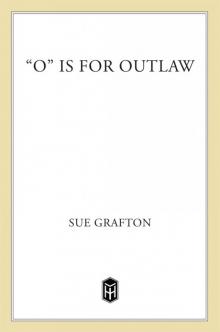 O Is for Outlaw
O Is for Outlaw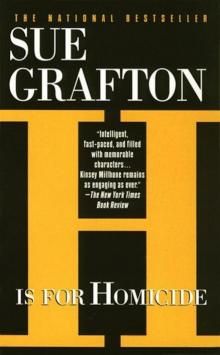 H Is for Homicide
H Is for Homicide X
X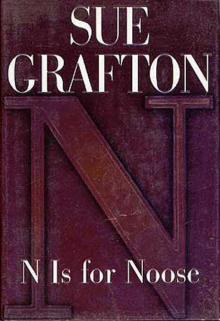 N Is for Noose
N Is for Noose Three Complete Novels: A Is for Alibi / B Is for Burglar / C Is for Corpse
Three Complete Novels: A Is for Alibi / B Is for Burglar / C Is for Corpse M Is for Malice
M Is for Malice I is for INNOCENT
I is for INNOCENT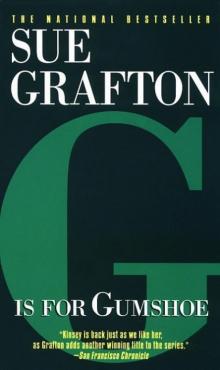 G is for GUMSHOE
G is for GUMSHOE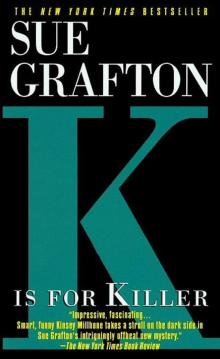 K is for KILLER
K is for KILLER S is for SILENCE
S is for SILENCE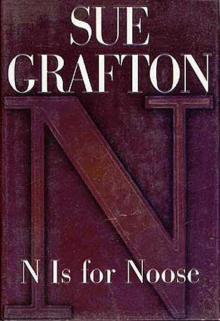 N is for NOOSE
N is for NOOSE D is for DEADBEAT
D is for DEADBEAT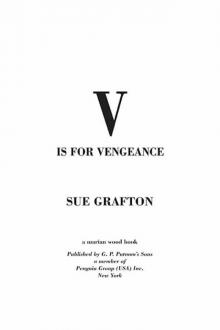 V is for Vengeance
V is for Vengeance U is for Undertow
U is for Undertow W Is for Wasted km-23
W Is for Wasted km-23 O is for OUTLAW
O is for OUTLAW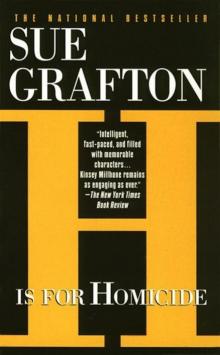 H is for HOMICIDE
H is for HOMICIDE Sue Grafton Novel Collection
Sue Grafton Novel Collection Kinsey and Me
Kinsey and Me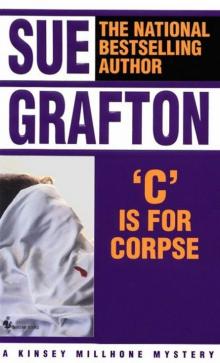 C is for CORPSE
C is for CORPSE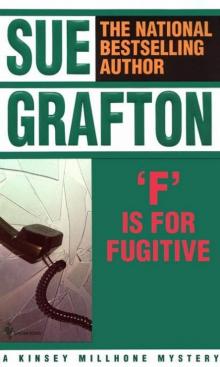 F is for FUGITIVE
F is for FUGITIVE B is for BURGLAR
B is for BURGLAR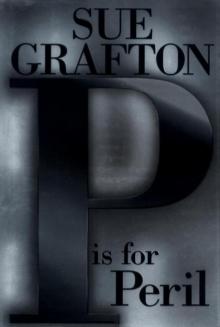 P is for PERIL
P is for PERIL A is for ALIBI
A is for ALIBI E is for EVIDENCE
E is for EVIDENCE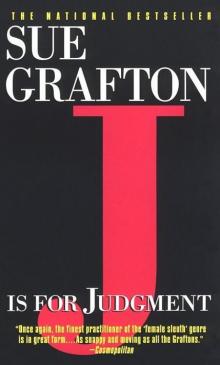 J is for JUDGMENT
J is for JUDGMENT Q is for QUARRY
Q is for QUARRY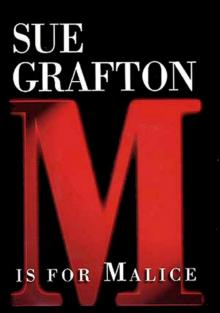 M is for MALICE
M is for MALICE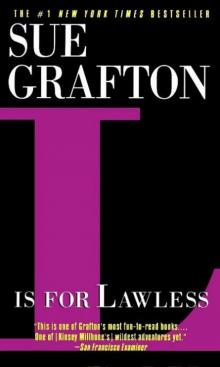 L is for LAWLESS
L is for LAWLESS